Black Hole Collision Calculator
You may think that black holes are mysterious objects that keep physicists up at night, but we actually know quite a lot about them. Come on in! With this calculator we hope to teach you what the event horizon is, what happens when an object collides with a black hole, and how to calculate the mass of a black hole from its size. And, as a bonus, the black hole collision calculator lets you create and play around with your own black hole collisions. Its astronomical fun!
What is a black hole?
We're pretty sure that you have all heard of black holes in some context or another; be it crazy theories about time travel or spooky manipulation of space and time. This might get you thinking that black holes are bizarre objects that nobody understands. The reality, fortunately, is different.
In general terms, black holes are one of the simplest objects to work with in the Universe. Its the details that make them strange and complicated, so let's get the basics right first.
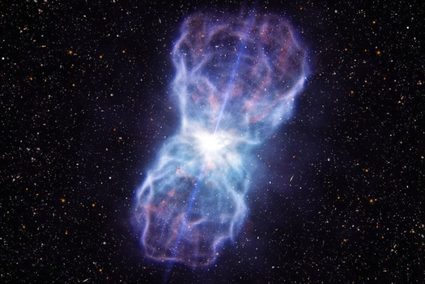
When a star is running out of 'fuel' to burn, it undergoes a series of processes that ends in the formation of one of three interstellar objects: a white dwarf, a neutron star or a black hole, each of them being denser than the previous one. You may visit the density calculator to compare the densities of various materials to gain some intuition of what that means.
For a star to become a black hole after its 'death', it needs to be at least 2-3 times the mass of our Sun. If this is the case, the gravitational pull of the star overwhelms the rest of the forces acting on it, and the remnant ends up collapsing into a single point of infinite density. Well, that's the theory anyway - there is no way to prove this last part empirically.
This point, also called the singularity, is surrounded by a region of space called the event horizon. Anything that enters the event horizon is trapped in the gravitational pull of the singularity, and so is gone from the rest of the Universe forever (well, ). This means we cannot see inside the event horizon, as not even photons can escape.
From a distance, however, black holes behave in a very simple and predictable way. We can treat them as a single point with a well-defined mass and calculate their gravitational effects on other objects with very simple equations; even Newtonian mechanics work if you are far enough away!
The event horizon of a black hole and the Schwarzschild radius
We have mentioned the term event horizon before, and now we will explore what it means and how to calculate it. Put simply; an event horizon is an imaginary line or surface that divides what we can possibly see from what we cannot. This does not refer to the accuracy of our measuring instruments, but rather to the limit of the knowledge we could obtain from a black hole, even with perfect instrumentation.
To escape from an object's gravitational field, we need to move in the opposite direction of the object attracting us, until there is no more gravitational attraction acting on us anymore. In physics, this is parametrized as the escape velocity - the velocity we would need to start with to escape from the surface of the attracting object.
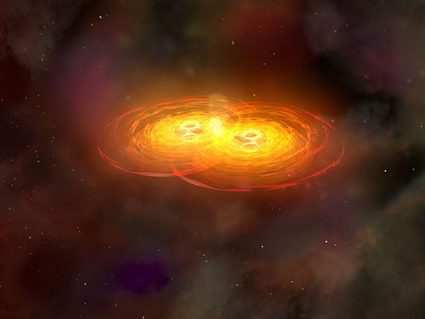
For example, the escape velocity on Earth is about 11.2 km/s, while on the Sun it's 617.8 km/s. These speeds are really fast, but we have put people on the Moon, and we could theoretically escape from the Sun. So then, what would happen then if we had an object whose escape velocity was faster than the fastest speed possible in the Universe - the speed of light?
If we had an object with a greater escape velocity than the speed of light, then nothing, not even light, can escape its gravitational pull. This would mean that the object would appear black (see where we're going?). Since we said before that black holes can be treated as single points in space, an object can get so close to one that the escape velocity would be greater than the speed of light, and therefore they never escape its clutches.
This limit, or point of no return, is what astronomers call the "event horizon". The idea was first introduced by Karl Schwarzschild, which is why the event horizon of a black hole is also known as its Schwarzschild radius. Anything inside of this sphere is hidden from us, and we cannot access it no matter how well we build instruments of detection.
How do we see black holes?
By now, it should be pretty obvious how black holes got their name, and why they are so mysterious and interesting for astronomers. In fact, you might be wondering right now How can we even see a black hole?. The short answer is: we can't. However, the long answer tells us that we can know of their existence by their effects on other objects.
There are two main types of interactions between black holes and other objects that bring light to its existence: destructive and non-destructive. Let's start with the less violent of the two, non-destructive.
In these kinds of interactions, astronomers observe a set of objects (mostly stars) orbiting around "nothing". This "nothing" has a very strong gravitational pull. After all other options are ruled out, the only thing it could possibly be is a black hole. We still can't see the black hole itself, but we know of its existence because of the way other objects react to its presence.
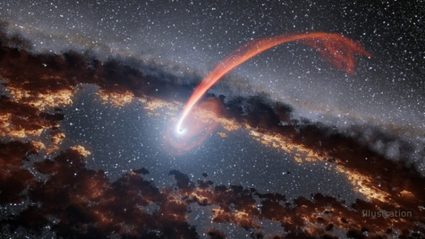
The more violent kind of interaction is also due to gravity, but this time the other objects involved get a little too close to the black hole and end up being swallowed by it. These events are rare, but when they occur, they create very bright flashes of energy, from infrared light to gamma rays.
These bursts of electromagnetic radiation are so bright that our telescopes can see them, even if the interaction happens outside our galaxy. With this data, we can learn not only the mass and size of the black hole, but also about its rotation, and, sometimes, even its charge (though that's a topic for another day), making them the most interesting of the black hole events.
From Earth, we can only see a bright flash of light coming from what was previously a dark spot. It means that supernovae are not a candidate, meaning that black holes the only real possibility - that we know about so far.
Tidal disruption and objects eaten by black holes
When an object, typically a star or a star remnant, falls into a black hole, a huge amount of energy is dispersed into the Universe. The amount of energy in this flash of light varies from about 3% to 42% of the mass of the object, depending on the properties of the black hole it falls into.
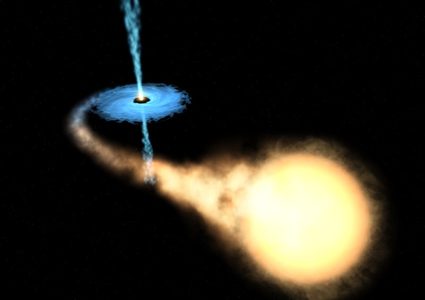
One of the most common ways in which an object falls into a black hole is what we call a tidal disruption event. In this case, when the star gets close to the black hole, different parts of it are attracted with different strengths, causing the star to be torn apart. Those bits that are closer to the black hole detach from the star and start spiraling around the black hole, before being "eaten" - i.e. passing into the event horizon and disappearing forever.
This could be one of the most beautiful sights in the universe, but we don't know. Even with state-of-the-art telescopes, we can barely see anything, which is a pity. However, that doesn't stop us from taking very good guesses at what it would look like from up close. We create simulations and artistic representations that just look gorgeous. We have sprinkled a couple of them throughout the text for you to indulge. We hope you've been enjoying them!
After lunch a star has been pulled into a black hole, the black hole experiences a net gain of mass, causing a corresponding increase of the Schwarzschild radius, or the event horizon. In simple terms, after the black hole has sucked in a star, it gains some of the mass of that star, which also causes the size to increase, since mass and size are closely related to each other.
This increase of mass depends on the energy liberated during the merging process. The amount of energy () released comes from some of the falling object's mass (). The relationship between the two is Einstein's famous formula: . Notice that this is also referred to as a rest mass energy; in other words, there is no description of the energy related to the movement (which is described in the kinetic energy calculator). Interestingly, this term is usually expressed in terms of momentum - a quantity which is explained in more detail in the impulse and momentum calculator.
How much energy is released depends on many factors, but, as an initial approximation, one can assume that for a non-rotating black hole the amount of mass emitted is about 3% of the original mass of the falling object.
How to use the black hole collision calculator?
We hope you found all of that preamble interesting, but now it's time to do some calculating! With this black hole collision calculator, you will be able to calculate what happens when a black hole collides with any other object in the Universe.

First, we need to describe what is happening before the collision: a star wandering the Universe, minding its own business. Oh no star! Look out for that black hole! To set up the initial conditions of this scenario, we need the mass of the object being eaten () and the mass of the black hole (). You can also use the event horizon's radius () since a black hole's mass and radius are related.
Now we jump to the situation after the collision, when the object has fallen completely into the black hole, becoming part of it. In this case, the black hole has grown slightly. The mass gained by the black hole is the initial mass of the other object minus the mass that was converted into energy. The new mass of the black hole, together with the total energy released and the new event horizon radius, are computed and shown to you in the black hole collision calculator.

Feel free to play around with it and try as many different combinations as you like. For context, below are some ranges of masses expressed in relation to the mass of our own Sun ():
- Super Massive Black Holes:
- Intermediate Black Holes:
- Stellar Black Holes:
- Neutron Stars:
- Stars:
- Planets:
Oh! And one last remark, since the energies released in these events is greater than anything we will ever encounter or can even imagine in our lifetime, the units used are fairly uncommon. We have set a Bethe (also called a foe) as the default. This unit takes its name from the famous physicist Hans Bethe, who made up this unit since his work on supernovae constantly had to deal with energy of the order of . On the other hand, a foe is said to come from it's value in powers of 10 ergs: so ten to the fifty one ergs.
Approximations and simplifications
We mentioned at the beginning that black holes are simple as long as we don't get too close or look at them in too much detail. So, it's only fair that we at least mention what some of those details are, and why they were not included.
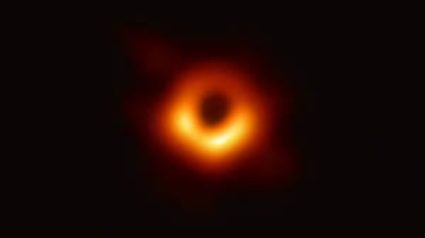
The eagle eyed among you might have noticed that we only briefly mentioned the rotation of black holes, and never went into further detail. So, why did we exclude it? That is because including the rotation of black holes into the equations and explanations complicates the topic to the degree that requires several pages of text and mathematical derivations to get a grasp on the general effects.
By sticking to non-rotating black holes, we have kept this calculator simple and easy to use. Most people would be put off by us digging into almost philosophical topics, such as: Could there exist a naked singularity? or How much does rotation affect the energy released in the collision? If answering these questions is going to keep you up until 4am, we suggest you check out these pages on and .
Finally, we thought it wise to make a small remark about the fact that the results of this calculator are estimations, and the fact that many other factors usually accompany black hole collisions. Some of these are the creation of gravitational waves, or the redshifting of the energy released as it travels through space.
